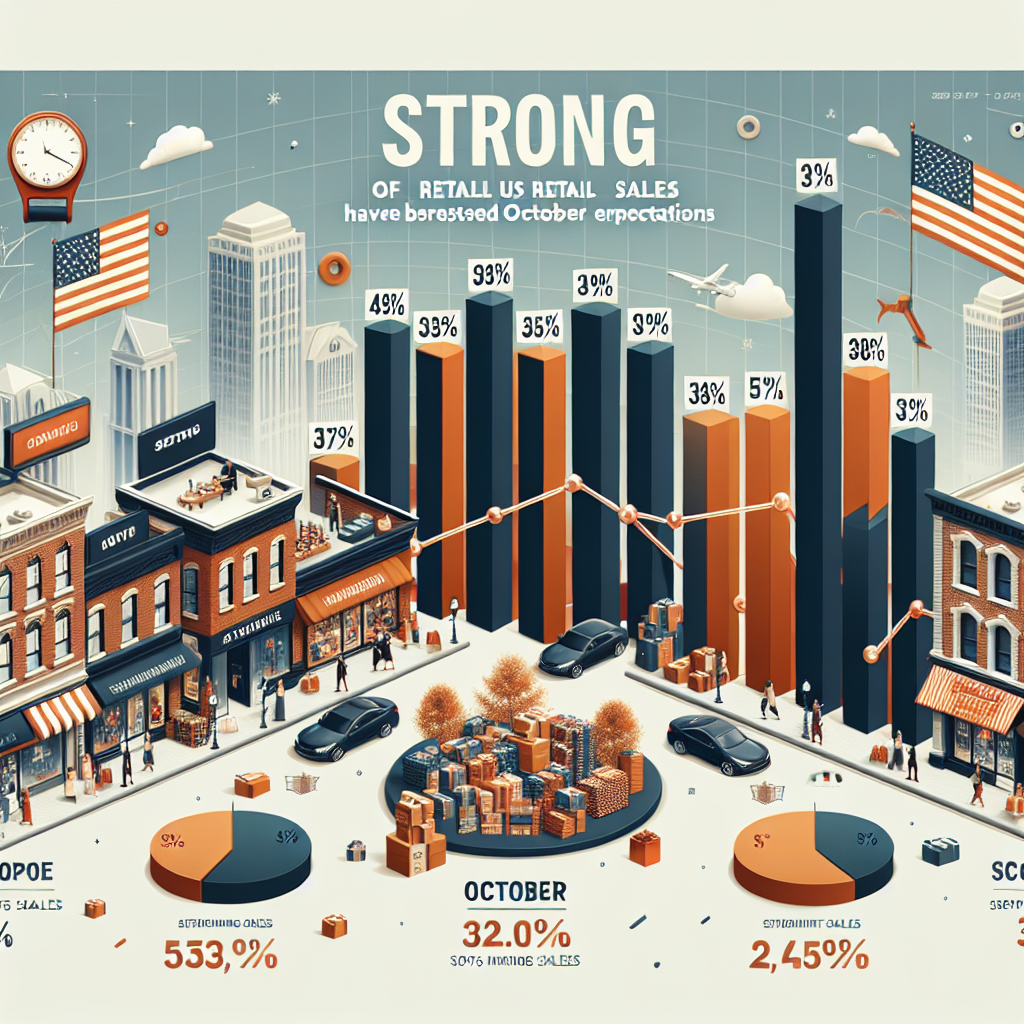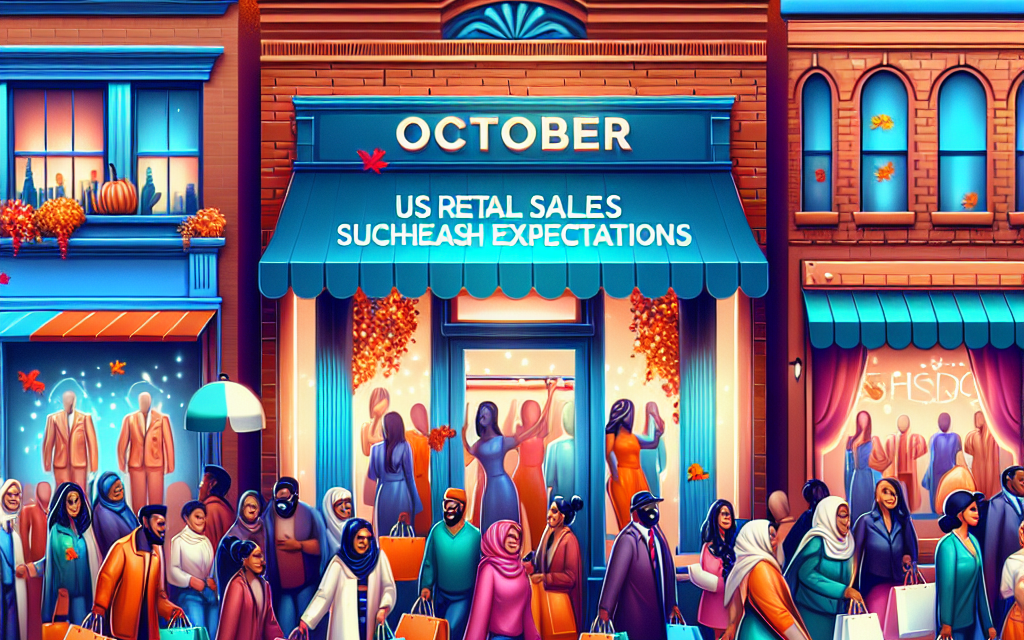“US Retail Sales Surge: October’s Unexpected Boom!”
Introduction
In October, U.S. retail sales exceeded expectations, signaling robust consumer spending and economic resilience. Despite concerns over inflation and potential economic slowdowns, the latest data revealed a stronger-than-anticipated performance across various retail sectors. This surge in sales highlights the continued confidence of American consumers and suggests a positive trajectory for the upcoming holiday shopping season. The unexpected growth in retail activity underscores the adaptability of retailers and the enduring demand for goods and services, providing a boost to economic forecasts and market sentiment.
Analysis Of Factors Driving US Retail Sales Growth In October
In October, US retail sales experienced a notable surge, surpassing expectations and providing a positive signal for the economy. This growth can be attributed to a confluence of factors that have collectively bolstered consumer spending, despite the challenges posed by inflationary pressures and global economic uncertainties. Understanding these driving forces offers valuable insights into the current state of the retail sector and the broader economic landscape.
One of the primary factors contributing to the robust retail sales in October is the sustained strength of the labor market. With unemployment rates remaining low, more individuals have disposable income, which in turn fuels consumer spending. The increase in employment opportunities has not only provided financial stability for many households but has also boosted consumer confidence. This confidence is crucial, as it encourages individuals to spend more freely, thereby stimulating retail sales.
Moreover, the easing of supply chain disruptions has played a significant role in supporting retail growth. Over the past year, supply chain bottlenecks have been a persistent issue, leading to product shortages and delayed deliveries. However, recent improvements in logistics and transportation have alleviated some of these challenges, allowing retailers to restock their shelves more efficiently. As a result, consumers have had greater access to a wider array of products, which has contributed to the increase in sales.
In addition to these factors, the strategic use of promotional activities by retailers has also been instrumental in driving sales. October is traditionally a month when retailers begin to ramp up their marketing efforts in anticipation of the holiday season. This year, many retailers have offered early discounts and promotions to entice consumers to start their holiday shopping earlier than usual. These marketing strategies have successfully attracted consumers, leading to higher sales volumes.
Furthermore, the shift in consumer preferences towards online shopping has continued to influence retail sales dynamics. The convenience and accessibility of e-commerce platforms have made it easier for consumers to make purchases from the comfort of their homes. Retailers that have invested in enhancing their online presence and optimizing their digital platforms have reaped the benefits of this trend. The growth in online sales has complemented in-store purchases, contributing to the overall increase in retail sales.
While these factors have collectively driven retail sales growth, it is important to acknowledge the challenges that persist. Inflation remains a significant concern, as rising prices can erode purchasing power and dampen consumer spending. However, the recent moderation in inflation rates has provided some relief, allowing consumers to maintain their spending levels. Additionally, geopolitical tensions and global economic uncertainties continue to pose risks to the retail sector, as they can impact consumer sentiment and disrupt supply chains.
In conclusion, the surpassing of retail sales expectations in October is a testament to the resilience of the US economy and the adaptability of the retail sector. The interplay of a strong labor market, improved supply chain conditions, effective promotional strategies, and the ongoing shift towards e-commerce has created a favorable environment for retail growth. As the holiday season approaches, it will be crucial for retailers to continue leveraging these factors while remaining vigilant of potential challenges. By doing so, they can sustain the momentum and contribute to the overall economic recovery.
Impact Of Consumer Confidence On October Retail Sales
In October, US retail sales exceeded expectations, reflecting a robust consumer confidence that has been pivotal in driving economic activity. This unexpected surge in retail sales underscores the resilience of the American consumer, even amid fluctuating economic indicators and global uncertainties. The data, released by the Commerce Department, revealed a notable increase in consumer spending, which is a critical component of the nation’s economic health. This uptick in retail sales is not merely a reflection of increased consumer spending but also an indicator of broader economic trends that have been shaping the market landscape.
Consumer confidence, a key driver of retail sales, has shown remarkable strength in recent months. This confidence is largely attributed to a stable job market, rising wages, and a decrease in unemployment rates, which have collectively bolstered consumers’ willingness to spend. As consumers feel more secure in their financial situations, they are more likely to make discretionary purchases, thereby fueling retail growth. Moreover, the holiday season’s approach has historically been a period of increased consumer activity, and this year appears to be no exception. Retailers have been preparing for this surge by stocking up on inventory and offering early promotions to entice shoppers.
Furthermore, the impact of consumer confidence on retail sales is evident in the diverse range of sectors that have experienced growth. For instance, the automotive industry saw a significant rise in sales, driven by both new vehicle purchases and increased demand for used cars. Similarly, the electronics and home appliance sectors reported higher sales figures, suggesting that consumers are investing in durable goods. This trend is indicative of a broader shift in consumer behavior, where individuals are prioritizing long-term investments over short-term consumption.
In addition to these factors, the role of e-commerce cannot be overlooked. The convenience and accessibility of online shopping have continued to attract consumers, contributing to the overall increase in retail sales. Retailers with a strong online presence have particularly benefited from this trend, as they are able to reach a wider audience and offer competitive pricing. The integration of technology in retail has also enhanced the shopping experience, with personalized recommendations and seamless payment options encouraging consumers to spend more.
However, it is important to consider the potential challenges that could impact future retail sales. Inflationary pressures, for instance, remain a concern, as rising prices could eventually dampen consumer spending. Additionally, supply chain disruptions, which have been a persistent issue since the onset of the pandemic, could affect inventory levels and product availability. Retailers must navigate these challenges carefully to sustain the momentum in sales.
In conclusion, the surpassing of October retail sales expectations highlights the significant role of consumer confidence in driving economic growth. While the current landscape appears favorable, it is essential for both retailers and policymakers to remain vigilant and responsive to emerging challenges. By understanding the underlying factors that influence consumer behavior, stakeholders can better anticipate market trends and make informed decisions that support continued economic prosperity. As the year progresses, monitoring these dynamics will be crucial in assessing the long-term trajectory of the retail sector and its contribution to the broader economy.
How E-commerce Contributed To Surpassing October Retail Sales Expectations
In October, US retail sales exceeded expectations, marking a significant milestone in the economic landscape. This achievement can be largely attributed to the robust performance of the e-commerce sector, which has become an integral component of the retail industry. As consumers increasingly turn to online platforms for their shopping needs, e-commerce has played a pivotal role in driving retail sales beyond anticipated levels. This shift in consumer behavior is not only reshaping the retail market but also highlighting the growing importance of digital platforms in the modern economy.
To begin with, the convenience offered by e-commerce platforms has been a major factor in their success. Consumers are drawn to the ease of shopping from the comfort of their homes, avoiding the need to travel to physical stores. This convenience is further enhanced by the ability to compare prices, read reviews, and access a wider range of products than what is typically available in brick-and-mortar stores. As a result, more consumers are opting for online shopping, contributing to the surge in retail sales.
Moreover, the advancements in technology have significantly improved the online shopping experience. Enhanced website interfaces, mobile-friendly platforms, and secure payment systems have made it easier and safer for consumers to make purchases online. Additionally, the use of data analytics and artificial intelligence has allowed e-commerce companies to personalize the shopping experience, offering tailored recommendations and promotions that resonate with individual consumers. This personalized approach not only increases customer satisfaction but also encourages repeat purchases, further boosting sales figures.
In addition to these factors, the role of social media in promoting e-commerce cannot be overlooked. Social media platforms have become powerful marketing tools, enabling retailers to reach a broader audience and engage with consumers in real-time. Through targeted advertising and influencer partnerships, retailers can effectively promote their products and drive traffic to their online stores. This increased visibility and engagement have been instrumental in attracting new customers and retaining existing ones, thereby contributing to the overall growth in retail sales.
Furthermore, the logistical capabilities of e-commerce companies have also played a crucial role in their success. Efficient supply chain management and fast delivery services have become key differentiators in the competitive online retail market. Companies that can offer quick and reliable delivery options are more likely to attract and retain customers, as timely delivery is a critical factor in the online shopping experience. By investing in logistics infrastructure and optimizing their supply chains, e-commerce companies have been able to meet the growing demand and ensure customer satisfaction.
It is also important to consider the impact of seasonal factors on retail sales. October marks the beginning of the holiday shopping season, with events such as Halloween and early Black Friday sales driving consumer spending. E-commerce platforms have capitalized on these opportunities by offering exclusive online deals and promotions, enticing consumers to make purchases ahead of the traditional holiday rush. This strategic approach has not only boosted sales in October but also set the stage for continued growth in the coming months.
In conclusion, the surpassing of October retail sales expectations can be largely attributed to the dynamic and evolving e-commerce sector. Through convenience, technological advancements, social media engagement, logistical efficiency, and strategic marketing, e-commerce has become a driving force in the retail industry. As consumer preferences continue to shift towards online shopping, it is evident that e-commerce will remain a key contributor to retail sales growth in the future.
The Role Of Seasonal Promotions In Boosting October Retail Sales

In October, US retail sales exceeded expectations, marking a significant milestone in the economic landscape. This surge can be largely attributed to the strategic implementation of seasonal promotions by retailers, which played a pivotal role in driving consumer spending. As the holiday season approaches, businesses have increasingly leveraged promotional strategies to entice consumers, creating a ripple effect that has positively impacted retail sales figures.
One of the primary factors contributing to the rise in retail sales is the early onset of holiday promotions. Retailers have recognized the importance of capturing consumer interest well before the traditional holiday shopping period. By launching promotions in October, businesses have successfully extended the shopping season, encouraging consumers to make purchases earlier than usual. This strategic move not only helps in managing inventory more effectively but also reduces the pressure on supply chains, which have been under strain in recent years.
Moreover, the use of targeted marketing campaigns has been instrumental in boosting sales. Retailers have employed data analytics to understand consumer preferences and tailor their promotions accordingly. By offering personalized discounts and deals, businesses have been able to attract a wider audience, thereby increasing foot traffic both in physical stores and online platforms. This personalized approach has resonated well with consumers, who are more likely to respond positively to offers that align with their individual needs and preferences.
In addition to personalized promotions, the integration of technology has further enhanced the shopping experience. Retailers have invested in digital platforms to provide seamless online shopping experiences, which have become increasingly important in the post-pandemic era. The convenience of online shopping, coupled with attractive promotions, has encouraged consumers to spend more, contributing to the overall increase in retail sales. Furthermore, the use of mobile apps and social media platforms has allowed retailers to reach consumers more effectively, providing real-time updates on promotions and deals.
Another significant aspect of the October retail sales surge is the impact of consumer confidence. As the economy shows signs of recovery, consumer confidence has been on the rise, leading to increased spending. Seasonal promotions have capitalized on this positive sentiment, encouraging consumers to indulge in discretionary spending. The combination of attractive deals and a favorable economic outlook has created an environment conducive to higher retail sales.
Additionally, the role of in-store experiences cannot be overlooked. Retailers have made concerted efforts to enhance the in-store shopping experience, recognizing that despite the growth of e-commerce, many consumers still value the tactile experience of shopping in physical stores. By offering exclusive in-store promotions and creating engaging shopping environments, retailers have successfully drawn consumers back to brick-and-mortar locations, further boosting sales.
In conclusion, the surpassing of October retail sales expectations can be attributed to a confluence of factors, with seasonal promotions playing a central role. The strategic timing of promotions, coupled with personalized marketing and enhanced shopping experiences, has effectively driven consumer spending. As retailers continue to innovate and adapt to changing consumer behaviors, the outlook for the upcoming holiday season remains optimistic. The success of October’s retail sales serves as a testament to the power of well-executed promotional strategies in shaping consumer behavior and driving economic growth.
Comparison Of October Retail Sales With Previous Months
In October, US retail sales demonstrated a robust performance, surpassing expectations and providing a positive signal for the economy. This development marks a significant shift from the preceding months, where retail sales exhibited a more moderate growth trajectory. To understand the implications of this surge, it is essential to compare October’s retail sales with those of previous months, thereby highlighting the factors contributing to this unexpected upswing.
Throughout the summer months, retail sales in the United States experienced a steady, albeit modest, increase. This period was characterized by cautious consumer spending, influenced by a combination of factors such as inflationary pressures, fluctuating fuel prices, and lingering uncertainties in the global economic landscape. In July and August, retail sales figures showed incremental growth, with consumers prioritizing essential goods over discretionary spending. September, however, saw a slight dip in sales, attributed to back-to-school expenses tapering off and consumers becoming more conservative in their spending habits.
In contrast, October’s retail sales figures painted a more optimistic picture. The surge in sales can be attributed to several key factors that collectively contributed to this unexpected growth. Firstly, the labor market continued to show resilience, with unemployment rates remaining low and wage growth providing consumers with increased purchasing power. This economic stability instilled confidence among consumers, encouraging them to spend more freely.
Moreover, the easing of supply chain disruptions, which had previously constrained the availability of goods, played a crucial role in boosting retail sales. Retailers were better equipped to meet consumer demand, ensuring that shelves were stocked with a wide array of products. This improved availability, coupled with strategic promotional activities by retailers, enticed consumers to make purchases they might have otherwise postponed.
Additionally, the onset of the holiday shopping season, which traditionally begins in October, further fueled retail sales. Retailers launched early promotions and discounts to capture consumer interest, effectively extending the holiday shopping period. This strategy not only attracted early-bird shoppers but also spread consumer spending more evenly across the months leading up to the end of the year.
Comparing October’s performance with previous months, it becomes evident that consumer sentiment has shifted positively. While the summer months were marked by caution and restraint, October saw a renewed willingness among consumers to engage in discretionary spending. This change in behavior suggests that consumers are adapting to the current economic environment, balancing their concerns about inflation with the desire to maintain their standard of living.
Furthermore, the data indicates that certain retail sectors experienced more pronounced growth than others. For instance, electronics and home goods saw significant increases in sales, driven by both seasonal demand and the availability of new product releases. In contrast, sectors such as apparel and dining, while still experiencing growth, did not see as dramatic an increase, reflecting ongoing shifts in consumer preferences and priorities.
In conclusion, October’s retail sales performance stands out as a beacon of economic resilience, surpassing expectations and providing a hopeful outlook for the remainder of the year. By comparing these figures with those of previous months, it is clear that a combination of factors, including a stable labor market, improved supply chains, and strategic retail initiatives, have contributed to this positive trend. As the holiday season progresses, it will be crucial to monitor whether this momentum can be sustained, offering further insights into the evolving dynamics of consumer behavior in the United States.
Implications Of October Retail Sales On The US Economy
In October, US retail sales exceeded expectations, marking a significant development in the economic landscape. This unexpected surge in consumer spending has sparked discussions among economists and policymakers about its potential implications for the broader US economy. As retail sales are a critical component of economic health, this uptick suggests a robust consumer confidence that could drive further economic growth. The increase in retail sales is particularly noteworthy given the backdrop of economic uncertainties, including fluctuating interest rates and global supply chain disruptions. These factors have previously cast a shadow over consumer spending, making the October figures a welcome surprise.
The rise in retail sales can be attributed to several factors, including a strong labor market and rising wages, which have bolstered disposable income for many Americans. Additionally, the easing of pandemic-related restrictions has encouraged consumers to return to physical stores, contributing to the overall increase in sales. This shift back to in-person shopping has been complemented by a sustained growth in e-commerce, indicating a hybrid model of consumer behavior that is likely to persist. Moreover, seasonal factors such as early holiday shopping and promotional events have also played a role in boosting sales figures for October.
The implications of this retail sales surge are multifaceted. On one hand, it signals a resilient economy that is capable of withstanding external pressures. This resilience is crucial as the Federal Reserve continues to navigate the delicate balance of controlling inflation without stifling growth. The robust retail sales data may provide the Fed with some leeway to maintain its current monetary policy stance, potentially delaying any aggressive interest rate hikes. On the other hand, sustained consumer spending could contribute to inflationary pressures, complicating the Fed’s efforts to achieve price stability.
Furthermore, the increase in retail sales has positive implications for the labor market. As retailers experience higher demand, they may be prompted to hire additional staff, thereby reducing unemployment rates and further stimulating economic activity. This potential for job creation is particularly important as it can lead to a virtuous cycle of increased consumer spending, further bolstering economic growth. However, it is essential to consider the potential challenges that may arise from this scenario. For instance, if demand continues to outpace supply, it could exacerbate existing supply chain issues, leading to higher prices and potential shortages.
In addition to its impact on monetary policy and the labor market, the rise in retail sales also has implications for fiscal policy. Policymakers may view the strong sales data as an indication that the economy is on a stable footing, potentially influencing decisions regarding government spending and taxation. This could lead to a reevaluation of fiscal stimulus measures, with a focus on targeted interventions that support long-term economic growth.
In conclusion, the surpassing of October retail sales expectations presents a complex picture for the US economy. While it underscores consumer confidence and economic resilience, it also poses challenges related to inflation and supply chain management. As policymakers and economists analyze these developments, the focus will likely be on ensuring that this momentum is sustained in a manner that supports balanced and inclusive growth. The coming months will be critical in determining how these dynamics unfold and what strategies will be employed to navigate the evolving economic landscape.
Future Projections Based On October Retail Sales Data
In October, US retail sales exceeded expectations, providing a promising outlook for the future of the American economy. This unexpected surge in consumer spending has prompted analysts to revise their projections for the coming months, suggesting a more robust economic recovery than previously anticipated. The data, which reflects a broad-based increase across various retail sectors, indicates that consumer confidence is on the rise, a critical factor in sustaining economic growth.
The October retail sales data revealed a 1.3% increase, surpassing the anticipated 0.7% growth. This uptick can be attributed to several factors, including a strong labor market, rising wages, and a decrease in unemployment rates. As more Americans find themselves with disposable income, their propensity to spend has naturally increased, fueling retail growth. Moreover, the easing of supply chain disruptions has allowed retailers to stock their shelves more effectively, meeting consumer demand more efficiently than in previous months.
Transitioning to the implications of this data, it is essential to consider how these trends might influence future economic projections. The retail sector is a significant component of the US economy, accounting for approximately 70% of GDP. Therefore, sustained growth in this area could signal a broader economic upswing. Analysts are now revisiting their forecasts, with many predicting that the fourth quarter will see continued momentum in consumer spending. This optimism is further bolstered by the upcoming holiday season, traditionally a peak period for retail sales.
In addition to the immediate impact on economic forecasts, the October retail sales data also offers insights into consumer behavior trends. The increase was not limited to a single category but was spread across various sectors, including electronics, clothing, and home goods. This diversification suggests that consumers are not only spending more but are also willing to invest in a range of products, reflecting a balanced approach to their purchasing decisions. Such behavior could indicate a shift towards more sustainable spending patterns, which would be beneficial for long-term economic stability.
Furthermore, the rise in retail sales has implications for monetary policy. The Federal Reserve closely monitors consumer spending as an indicator of economic health. With retail sales surpassing expectations, there may be less pressure on the Fed to implement aggressive interest rate hikes to curb inflation. Instead, policymakers might adopt a more measured approach, allowing the economy to grow steadily without overheating. This balance is crucial for maintaining economic stability and ensuring that growth is sustainable over the long term.
Looking ahead, the positive retail sales data from October sets a hopeful tone for the future. However, it is important to remain cautious, as several external factors could influence these projections. Global economic uncertainties, potential geopolitical tensions, and fluctuations in energy prices are all variables that could impact consumer confidence and spending. Therefore, while the current data is encouraging, it is essential for businesses and policymakers to remain vigilant and adaptable to changing circumstances.
In conclusion, the October retail sales figures have exceeded expectations, providing a boost to economic forecasts and offering valuable insights into consumer behavior. As the US economy continues to recover, the retail sector’s performance will be a critical indicator of future growth. By understanding the factors driving this increase and considering potential challenges, stakeholders can better prepare for the opportunities and risks that lie ahead.
Q&A
1. **What was the percentage increase in US retail sales for October?**
US retail sales increased by 1.3% in October.
2. **Which sectors contributed most to the retail sales growth in October?**
The sectors that contributed most were motor vehicles and parts dealers, food and beverage stores, and gasoline stations.
3. **How did online sales perform in October compared to previous months?**
Online sales saw a significant increase, continuing their upward trend from previous months.
4. **What impact did inflation have on retail sales in October?**
Despite high inflation, consumer spending remained strong, contributing to the unexpected rise in retail sales.
5. **How did October’s retail sales compare to economists’ expectations?**
October’s retail sales surpassed economists’ expectations, which had predicted a more modest increase.
6. **What role did consumer confidence play in the October retail sales figures?**
Increased consumer confidence, driven by a strong labor market and wage growth, played a key role in boosting retail sales.
7. **How might the Federal Reserve respond to the October retail sales data?**
The Federal Reserve might consider the strong retail sales data as a factor in deciding future interest rate hikes to manage inflation.
Conclusion
In October, US retail sales exceeded expectations, indicating robust consumer spending despite economic uncertainties. This surge suggests that consumers remain resilient, potentially fueled by strong employment figures and wage growth. The better-than-expected retail performance may alleviate some recession concerns and could influence the Federal Reserve’s monetary policy decisions. However, sustained growth will depend on factors such as inflation trends, interest rates, and consumer confidence in the coming months. Overall, the October retail sales data underscores the strength of the US consumer market and its critical role in driving economic activity.





